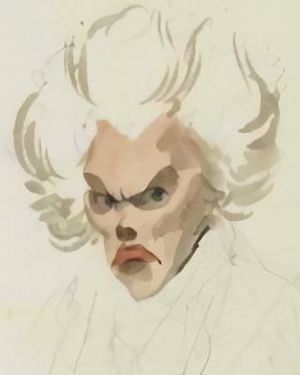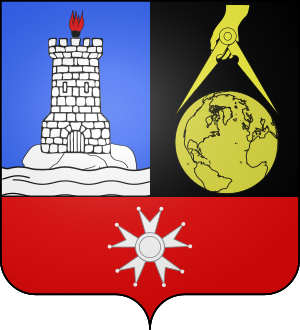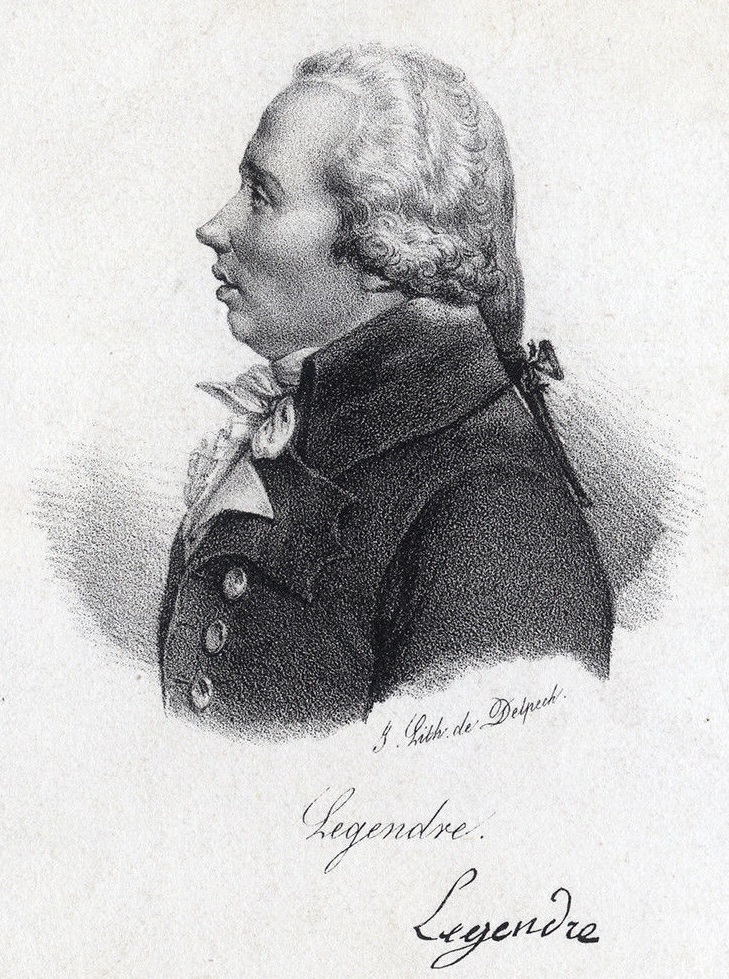Adrien-Marie Legendre facts for kids
Quick facts for kids
Adrien-Marie Legendre
|
|
|---|---|

Watercolor caricature by Julien-Léopold Boilly (see § Mistaken portrait), the only known portrait of Legendre
|
|
| Born | 18 September 1752 Paris, France
|
| Died | 9 January 1833 (aged 80) Paris, France
|
| Nationality | French |
| Alma mater | Collège Mazarin |
| Known for | Associated Legendre polynomials Legendre transformation Legendre polynomials Legendre transform Elliptic functions Introducing the character ∂ |
| Scientific career | |
| Fields | Mathematician |
| Institutions | École Militaire École Normale École Polytechnique |
| Influenced | Évariste Galois |
Adrien-Marie Legendre (born 18 September 1752 – died 9 January 1833) was a famous French mathematician. He made many important discoveries in math. You might know his name from things like the Legendre polynomials and the Legendre transformation, which are named after him.
Contents
Life
Adrien-Marie Legendre was born in Paris, France, on September 18, 1752. His family was quite wealthy. He went to school at the Collège Mazarin in Paris. In 1770, he finished his studies in physics and mathematics.
From 1775 to 1780, he taught at the École Militaire in Paris. Later, in 1795, he also taught at the École Normale. He also worked with the Bureau des Longitudes, which helped with navigation. In 1782, he won an award from the Berlin Academy. This was for his work on how objects move through air. This work also caught the eye of another famous mathematician, Lagrange.
In 1783, the Académie des sciences made Legendre a member. He became a full associate in 1785. In 1789, he was chosen to be a Fellow of the Royal Society in England.
Legendre helped with a big project called the Anglo-French Survey (1784–1790). This project aimed to measure the exact distance between the Paris Observatory and the Royal Greenwich Observatory. They used trigonometry to do this. In 1787, he visited Dover and London for this work. He went with Dominique, comte de Cassini and Pierre Méchain. The three also met William Herschel, who discovered the planet Uranus.
During the French Revolution in 1793, Legendre lost all his money. That same year, he married Marguerite-Claudine Couhin. She helped him get his life back in order. In 1795, he became one of six math members of the new Académie des Sciences. It was renamed the Institut National des Sciences et des Arts.
Later, in 1803, Napoleon changed the Institut National. Legendre became a member of the Geometry section. From 1799 to 1812, he checked the math skills of students at the École Militaire. He also did this for the École Polytechnique from 1799 to 1815.
In 1824, Legendre's retirement money was stopped. This happened because he refused to vote for the government's chosen candidate. His pension was partly given back in 1828 when the government changed. In 1831, he received the Légion d'Honneur, a high award in France.
Legendre passed away in Paris on January 9, 1833, after being sick for a long time. His wife kept his belongings carefully to remember him. When she died in 1856, she was buried next to him. They were buried in the village of Auteuil, where they had lived. She left their last country house to the village. Legendre's name is one of the 72 names written on the Eiffel Tower.
Mathematical Work
Legendre made many important contributions to different areas of mathematics.
He developed a very useful method called the least squares method. This method helps find the "best fit" line or curve for a set of data points. It is used a lot in linear regression, signal processing, and curve fitting. He published this method in 1806. The name "least squares method" comes directly from the French "méthode des moindres carrés."
One of his main works was Exercices de Calcul Intégral. This was a three-volume set published between 1811 and 1819. In these books, he wrote about elliptic functions, beta functions, and gamma functions. These are special types of mathematical functions. He also showed how these functions could be used to understand things like the Earth's rotation.
In number theory, which is the study of numbers, he suggested a rule called the quadratic reciprocity law. This law was later proven by Gauss. The Legendre symbol is named after him because of his work in this area. He also did early work on how prime numbers are spread out. Prime numbers are numbers that can only be divided by 1 and themselves.
Legendre did a lot of work on elliptic functions. These are special functions that come up in many areas of math and physics. Later, mathematicians like Abel and Jacobi built on his work.
He is also known for the Legendre transformation. This is a mathematical tool used in physics to change how we describe a system's energy. It's used in classical mechanics and thermodynamics. The Legendre polynomials are also named after him. These are solutions to a special math equation and are used often in physics and engineering. For example, they help describe electric fields.
Legendre is perhaps best known for his book Éléments de géométrie. It was published in 1794 and was a leading geometry textbook for about 100 years. This book made many of the ideas from Euclid's Elements easier to understand and use as a textbook.
Honors
- He was made an Honorary Member of the American Academy of Arts and Sciences in 1832.
- A crater on the Moon is named Legendre after him.
- An asteroid in space, 26950 Legendre, is named after him.
- Legendre is one of the 72 important French scientists whose names are written on the Eiffel Tower.
Mistaken Portrait
For about 200 years, people thought a certain portrait was of Adrien-Marie Legendre. Books, paintings, and articles showed a profile picture of a different person. This person was an unknown French politician named Louis Legendre (1752–1797). The mistake happened because the drawing was simply labeled "Legendre." It was found in a book with other mathematicians.
The only true portrait of Adrien-Marie Legendre was found in 2008. It's in a book from 1820 called Album de 73 portraits-charge aquarellés des membres de I'Institut. This book has funny drawings (caricatures) of 73 members of the Institut de France in Paris. The French artist Julien-Léopold Boilly drew them. You can see the correct portrait below, next to the one that was mistaken for him.
See Also
 In Spanish: Adrien-Marie Legendre para niños
In Spanish: Adrien-Marie Legendre para niños
- List of things named after Adrien-Marie Legendre
- Associated Legendre polynomials
- Gauss–Legendre algorithm
- Legendre's constant
- Legendre's equation in number theory
- Legendre's functional relation for elliptic integrals
- Legendre's conjecture
- Legendre sieve
- Legendre symbol
- Legendre's theorem on spherical triangles
- Saccheri–Legendre theorem
- Least squares
- Least-squares spectral analysis
- Seconds pendulum





